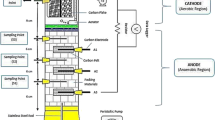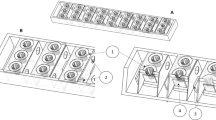Abstract
Effective wastewater treatment and electricity generation using dual-chamber microbial fuel cell (MFC) will require a better understanding of how operational parameters affect system performance. Therefore, the main aim of this study is to investigate the bioelectricity production in a dual-chambered MFC-operated batch mode under different operational conditions. Initially, platinum (Pt) and mixed metal oxide titanium (Ti-TiO2) electrodes were used to investigate the influence of the electrode materials on the power generation at initial dissolved organic carbon (DOC) concentration of 400 mg/L and cycle time of 15 days. MFC equipped with Ti-TiO2 electrode performed better and was used to examine the effect of influent DOC concentration and cycle time on MFC performance. Increasing influent DOC concentration resulted in improving electricity generation, corresponding to a 1.65-fold increase in power density. However, decrease in cycle time from 15 to 5 days adversely affected reactor performance. Maximum DOC removal was 90 ± 3 %, which was produced at 15-day cycle time with an initial DOC of 3,600 mg/L, corresponding to maximum power generation of about 7,205 mW/m2.




Similar content being viewed by others
References
Kim, M. H., Iwuchukwu, I. J., Wang, Y., Shin, D., Sanseverino, J., & Frymier, P. (2011). Journal of Power Sources, 196, 1909–1914.
Wei, L. L., Yuan, Z. L., Cui, M. J., Han, H. L., & Shen, J. Q. (2012). International Journal of Hydrogen Energy, 37, 1067–1073.
Digman, B., & Kim, D. S. (2008). Environmental Progress, 27(4), 524–537.
Logan, B. E., & Elimelech, M. (2012). Nature, 48, 313–319.
Logan, B., Hamelers, B., Rozendal, R., Schroeder, U., Keller, J., Freguiac, S., et al. (2006). Environmental Science and Technology, 40(17), 5181–5192.
Zhou, M., Chi, M., Luo, J., He, H., & Jin, T. (2011). Journal of Power Sources, 196, 4427–4435.
Zhao, Y., Watanabe, K., Nakamura, R., Mori, S., Liu, H., Ishii, K., et al. (2010). Chemistry A European Journal, 16, 4982–4985.
Zhang, G. D., Zhao, Q. L., Jiao, Y., Zhang, J. N., Jiang, J. Q., Ren, N. Q., et al. (2011). Journal of Power Sources, 196(15), 6036–6041.
Ozkaya, B., Akoglu, B., Karadag, D., Aci, G., Taksan, E., & Hasar, H. (2012). Bioprocess and Biosystems Engineering, 35, 1219–1227.
Tremouli, A., Antonopoulou, G., Bebelis, S., & Lyberatos, G. (2013). Bioresource Technology, 131, 380–389.
Logan, B. E. (2005). Water Science Technology, 52(1–2), 31–37.
Gonzalez Del Compo, A., Lobato, J., Canizares, P., Rodrigo, M. A., & Fernandez Moralez, F. J. (2013). Applied Energy, 101, 213–217.
Karadag, D. (2011). International Journal of Hydrogen Energy, 36, 458–465.
Qiao, Y., Li, C. M., Bao, S. J., & Bao, Q. L. (2007). Journal of Power Sources, 170(1), 79–84.
Qiao, Y., Bao, S. J., Li, C. M., Cui, X. Q., Lu, Z. S., & Guo, J. (2008). Acs Nano, 2(1), 113–119.
Gil, G. C., Chang, I. S., Kim, B. H., Kim, M., Jang, J. K., Park, H. S., et al. (2003). Biosensors and Biolelectronics, 18, 327–334.
Zhang, J., Zheng, P., Zhang, M., Chen, H., Chen, T., Xie, Z., et al. (2013). Bioresource Technology, 149, 44–50.
Ge, Z., Ping, Q., Xiao, L., & He, Z. (2013). Desalination, 312, 52–59.
Gálvez, A., Greenman, J., & Ieropoulos, I. (2009). Bioresource Technology, 100(21), 5085–5091.
Ozkaya, B., Cetinkaya, A. Y., Cakmakcı, M., Karadag, D., & Sahinkaya, E. (2013). Bioprocess and Biosystems Engineering, 36, 399–405.
Greenman, J., Gálvez, A., Giusti, L., & Ieropoulos, I. (2009). Enzyme and Microbial Technology, 44(2), 112–119.
Author information
Authors and Affiliations
Corresponding author
Rights and permissions
About this article
Cite this article
Cirik, K. Optimization of Bioelectricity Generation in Fed-Batch Microbial Fuel Cell: Effect of Electrode Material, Initial Substrate Concentration, and Cycle Time. Appl Biochem Biotechnol 173, 205–214 (2014). https://doi.org/10.1007/s12010-014-0834-1
Received:
Accepted:
Published:
Issue Date:
DOI: https://doi.org/10.1007/s12010-014-0834-1




